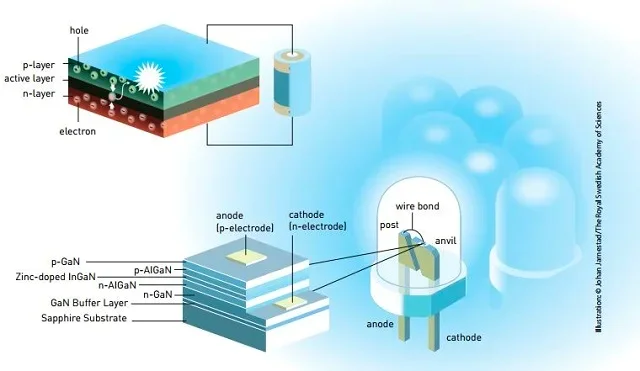Answer:
| Approach:
Introduction
- Start by acknowledging the 2014 Nobel Prize in Physics that was awarded to the inventors of Blue LEDs.
Body
- Discuss the specific areas where Blue LEDs have made significant impacts:
- Energy Efficiency and Cost Savings
- Catalyst for Digital Revolution
- Medical Applications and Healthcare
- Innovations in Agriculture
- Environmental Sustainability
● Conclusion: Conclude, emphasizing the transformative power of scientific advancements, as exemplified by the invention of Blue LEDs, on societal development. |
Introduction:
The 2014 Nobel Prize in Physics honoured Isamu Akasaki, Hiroshi Amano, and Shuji Nakamura for their pioneering invention of Blue Light Emitting Diodes (LEDs) in the 1990s. This technological breakthrough has had far-reaching implications, transforming various facets of human life globally and particularly in India.
Body:

Blue LEDs have made significant impacts in human life in following ways:
- Energy Efficiency and Cost Savings: Blue LEDs, vital for white LED lights, have revolutionized India’s approach to lighting.
- For instance, the government’s UJALA scheme, encouraging LED use, has distributed over 360 million LED bulbs nationwide as of 2021, significantly reducing household electricity costs and national energy consumption.
- Catalyst for Digital Revolution: Blue LEDs are integral to digital device screens, including smartphones and laptops.
- This technology has driven digital connectivity, as seen in the Pradhan Mantri Gramin Digital Saksharta Abhiyan, which aims to digitally literate 60 million rural households, facilitated by affordable LED-screen devices.
- Medical Applications and Healthcare: Blue LEDs have found critical applications in medical treatments, notably in phototherapy devices for neonatal jaundice.
- Devices like the Brilliance Pro, developed by Indian company D-Rev, use blue LEDs to provide affordable and effective treatment for thousands of Indian infants annually.
- Innovations in Agriculture: Blue LEDs, utilized in controlled-environment agriculture, improve plant growth.
- An example is Triton Food works, an Indian startup that uses LED lighting in its hydroponic farms, enabling year-round production irrespective of climatic variations.
- Environmental Sustainability: By reducing energy consumption and extending bulb lifespan, LED lights contribute to lower carbon emissions.
- This aligns with India’s commitment to reduce its carbon intensity under the Paris Agreement, enhancing environmental sustainability.
Conclusion:
The advent of Blue LEDs, a breakthrough invention, has permeated numerous sectors of everyday life in India, from energy conservation to digital literacy, healthcare, and sustainable agriculture. This serves as a testament to the profound societal transformations that innovative scientific research can engender.
